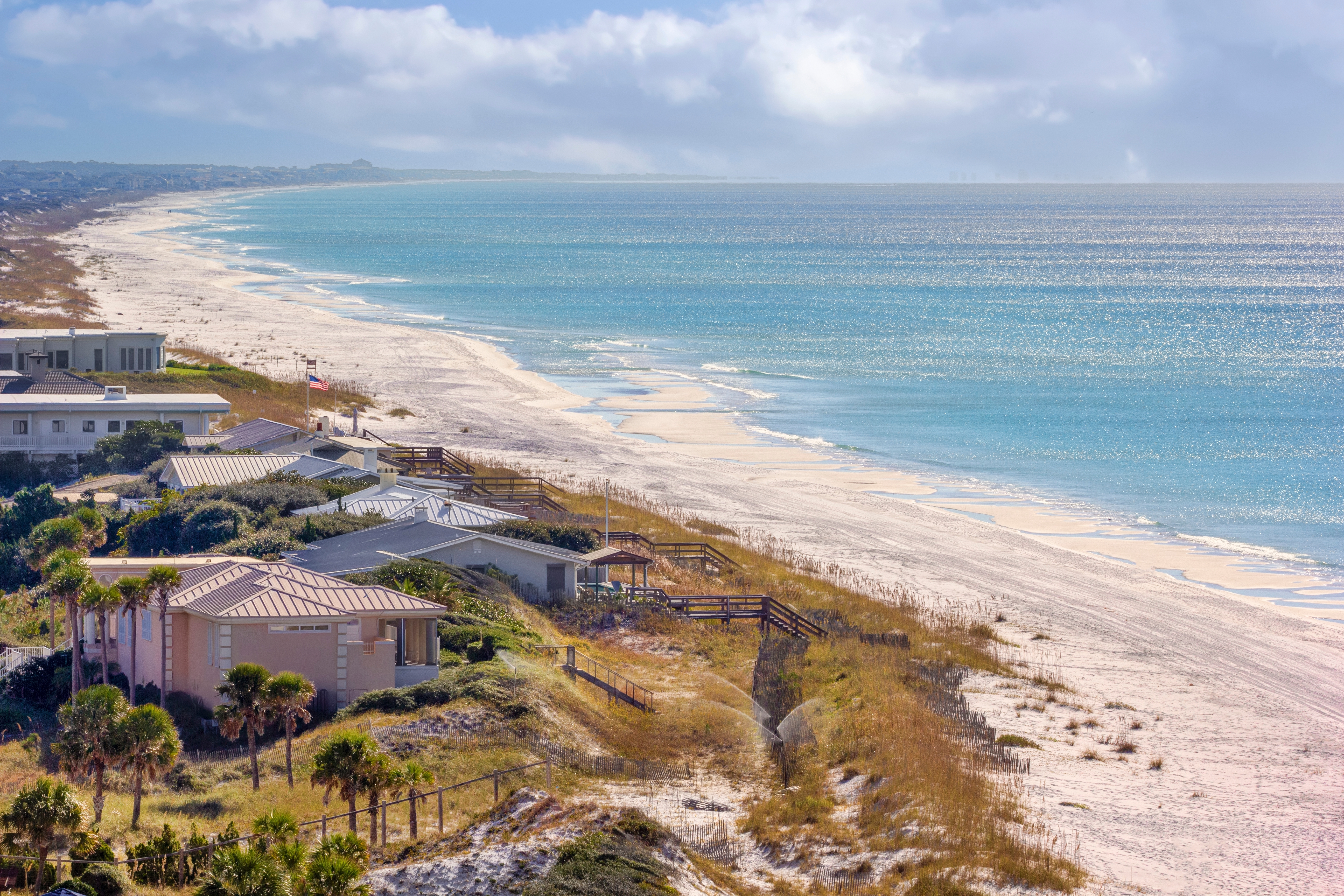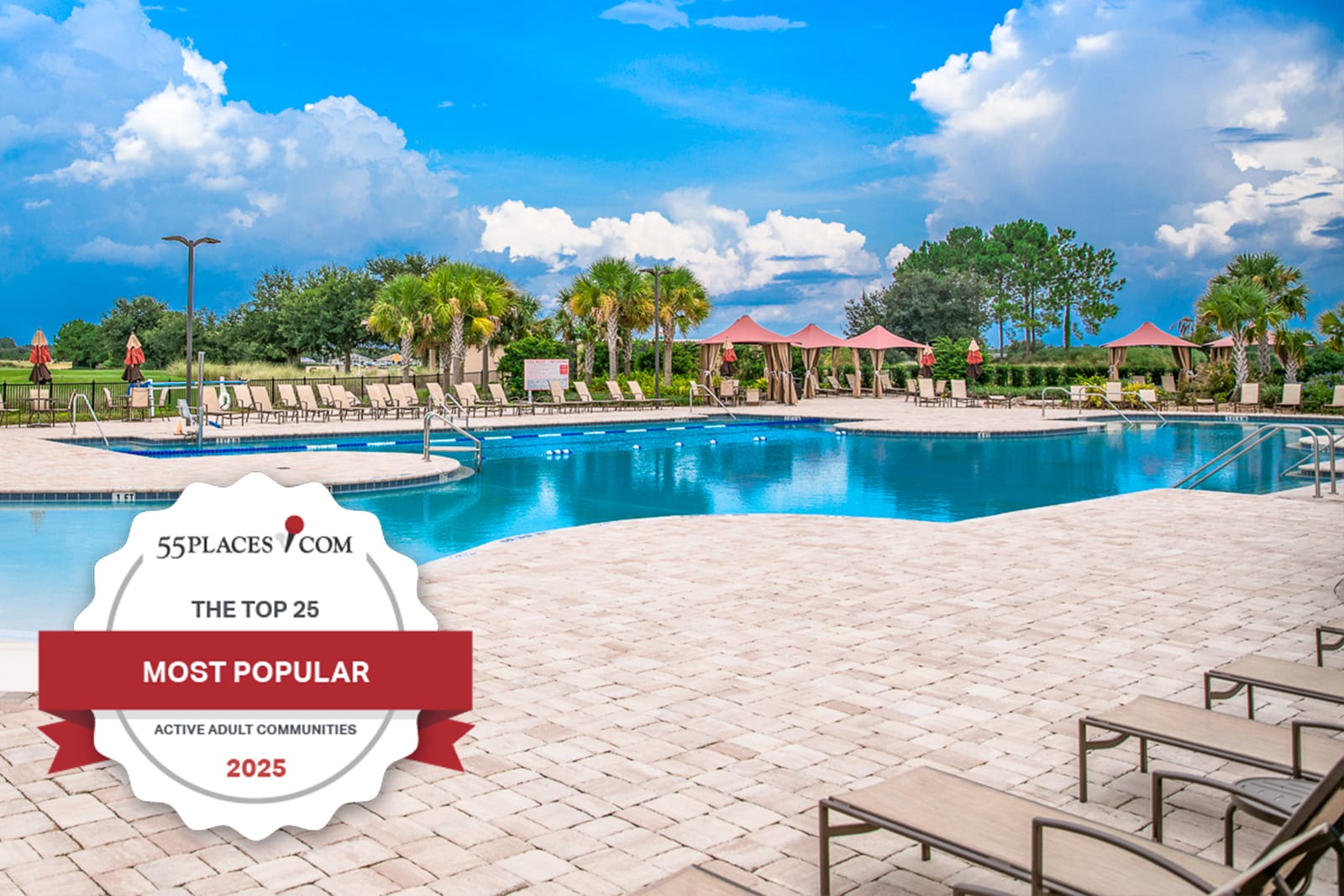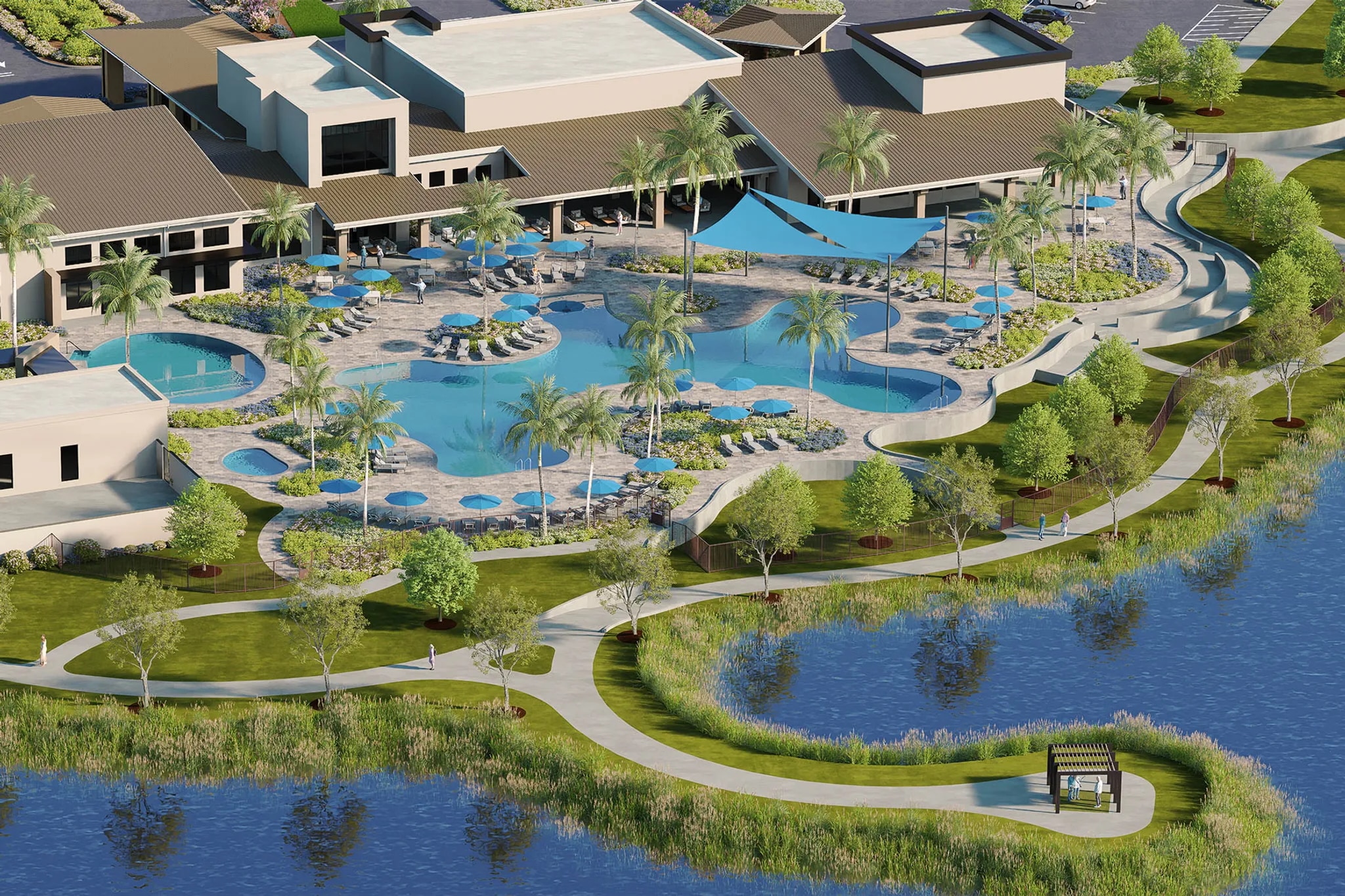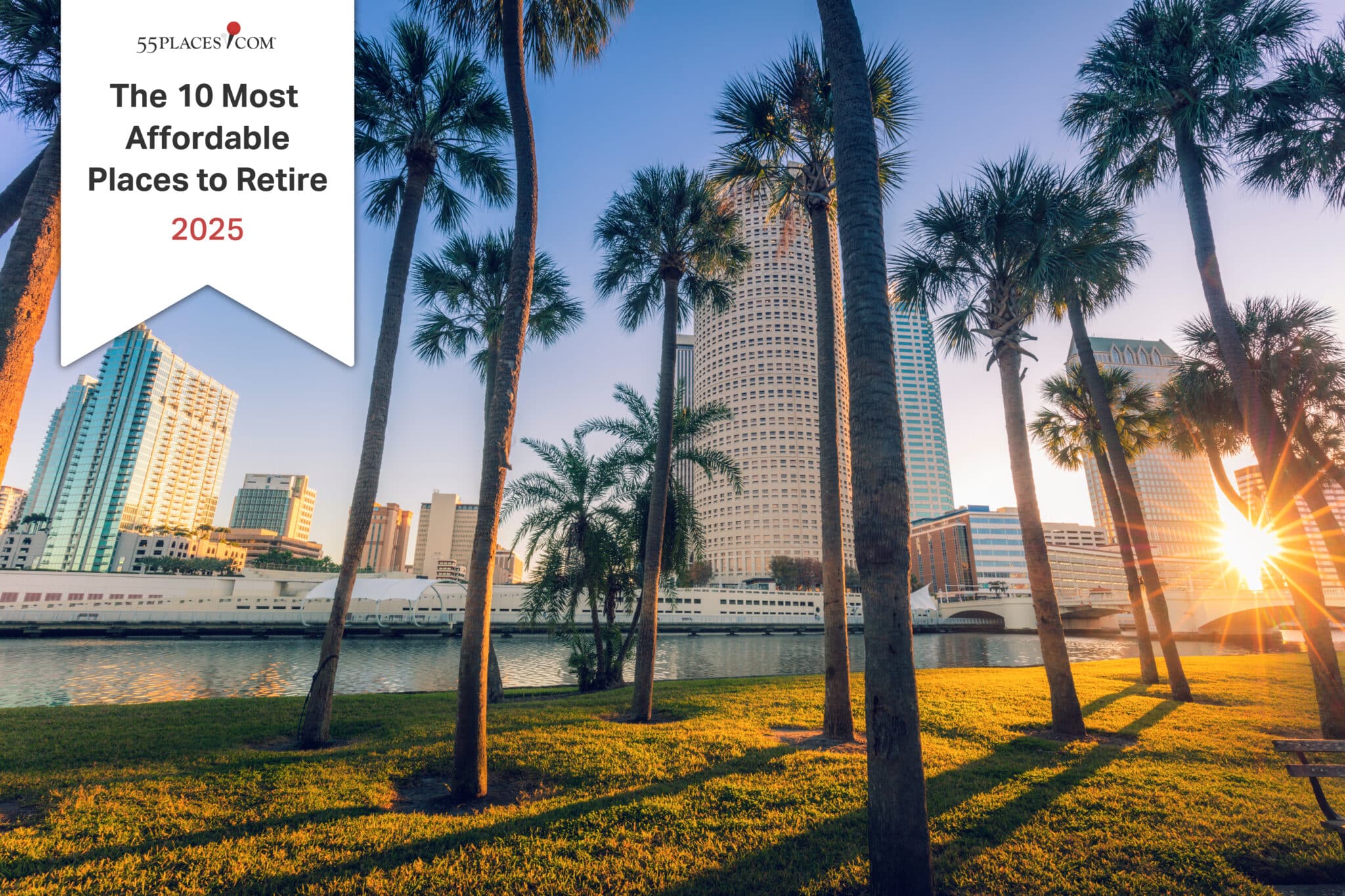North Florida and the Florida Panhandle offer retirees a distinct blend of small-town Southern charm and coastal beachfront living. For those seeking the best place to retire in Florida Panhandle, this region provides an appealing mix of affordability, laid-back communities, and scenic coastal beauty. Sandwiched between South Georgia and South Florida, the area has its own unique character. Compared to the more well-known and populated destinations in the Sunshine State, active adults often find that North Florida delivers a more affordable, less crowded, and relaxed retirement lifestyle.
The North Florida area is home to more than 500,000 residents, with over one-third of them being 55+ active adults. Cities like Tallahassee, Gainesville, Pensacola, Panama City, and Fernandina Beach attract retirees who desire an affordable retirement in a Florida beach town.
What makes North Florida such a great place for retirement? This extensive guide details the lifestyle factors, housing market trends, cost of living, health care, and the best places to retire in the Florida Panhandle and North Florida. Discover what makes this part of Florida the ideal retirement destination for many active adults.
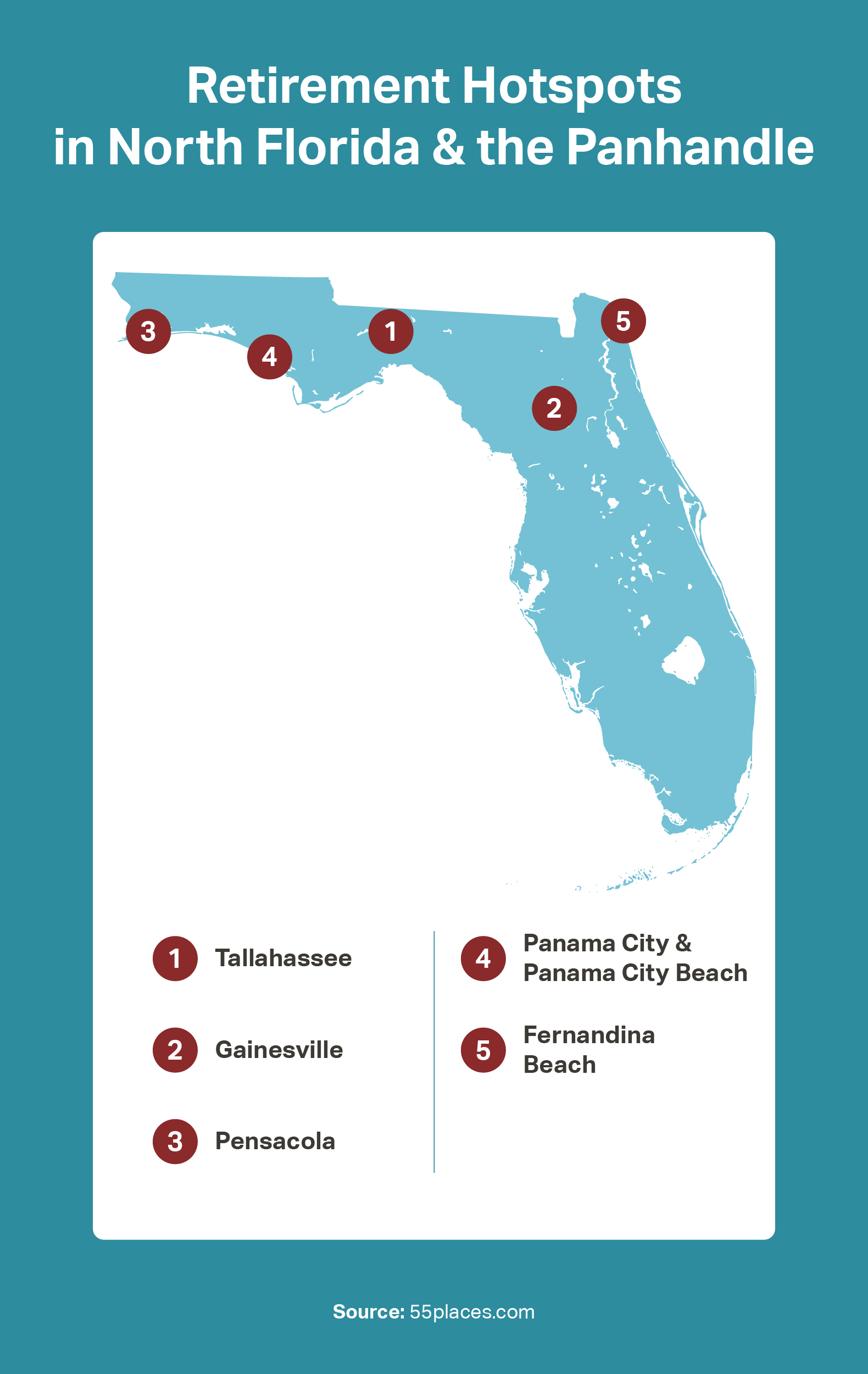
What It’s Like to Retire in North Florida and the Panhandle
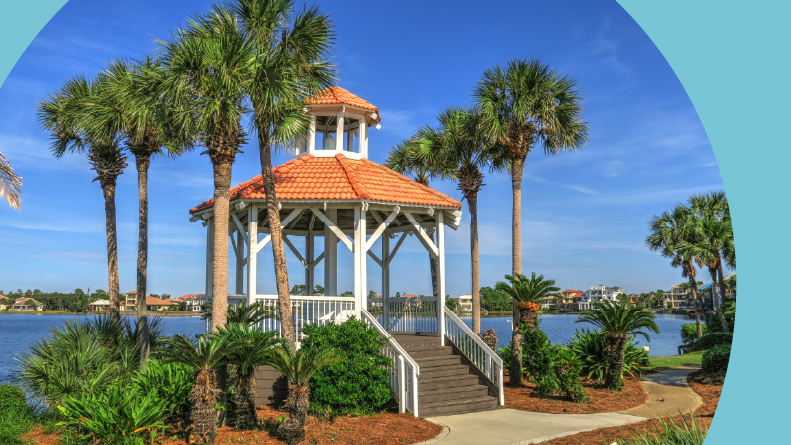
Pace of Life & Environment
North Florida may lack the tropical Caribbean vibe found in the opposite end of the state, but the Panhandle region boasts its own distinct atmosphere steeped in Southern charm and quiet, small-town living. In fact, the culture of North Florida more closely compares to other southeastern states like Alabama, Georgia, and South Carolina than it does to other in-state destinations like Key West.
In coastal cities like Panama City and Pensacola, retirees can expect waterfront seafood restaurants, white-sand beaches, and a fair amount of visitors from northern-bordering states in the summer looking to dip their toes in the sand. These lively cities include the entertainment, sports, and conveniences of big cities while maintaining the laid-back feel of being on vacation.
The small towns found between the coastal cities are quieter and feature beaches that rarely see large crowds. Locations like Mexico Beach, Destin, and Navarre work well for retirees looking to live near the Gulf Coast outside the hustle and bustle.
Life moves at a slower, more relaxed pace in the inland regions of the Panhandle. Other than Tallahassee, the capital of Florida and largest city in the Panhandle, retirees can expect small, forested towns complete with farmland, hospitable neighbors, and lots of space for outdoor recreation. Retirees seeking a location with a similar atmosphere to Alabama or Georgia, but with the tax benefits of living in the Sunshine State, can find their dream retirement destination in North Florida.
“As more retirees look for alternatives to higher-cost areas, the Panhandle and North Florida stand out. In 2025, we’re seeing growing interest from buyers who want affordability without sacrificing access to health care, entertainment, and outdoor recreation.”
-Khadeejah Johnson, Associate Vice President of Brokerage & Partnerships at 55places.com
Climate & Geography
The yearly weather in North Florida varies slightly from the tropical climate of South Florida. The Panhandle experiences four distinct seasons, though residents can still expect hot, muggy summers and pleasantly warm winters. While still oppressive, the summer humidity doesn’t quite reach the extremes it does farther south in the state.
A rare frost or snowfall may occur in a North Florida winter, though it becomes cool enough in the fall for deciduous trees to change color. Residents can expect ample rainfall throughout the year, especially in the summer months. It rains an average of 18 days in July, the wettest month.
Another difference between the climate of North and South Florida is that the coastal waters become slightly cooler on average in the Panhandle’s winter, dipping to the mid-60s in the coldest months. However, North Florida’s Gulf Coast beaches still offer opportunities for shell finding, fishing, and relaxation even when the water is a bit chillier.
In terms of its landscape, the Panhandle contains more deciduous forests and hilly terrain in its inland portions than the rest of Florida. Central Florida is typically flat and contains tropical flora, while the geography of the Panhandle is more comparable to other southeastern states like Alabama and Georgia.
Additional Resources
- The Best Places To Retire in Florida Without Hurricanes
- Weathering the Storm: Does an HOA Cover Hurricane Damage?
- The Most Affordable Places to Snowbird in Florida
- Fresh Alternatives to Florida for Retirement
Outdoor Lifestyle
North Florida offers bountiful opportunities for outdoor recreation. From inland forests to miles upon miles of pristine beaches, the Panhandle boasts natural beauty in abundance.
The Panhandle includes more than 200 miles of white sandy beaches along the Gulf Coast. Though many prefer to soak up the sun and swim during the summer, the year-round warm weather in Florida means the beaches can be enjoyed any month of the year. Beaches like Miramar Beach, Destin Beach, and Panama City Beach provide miles of sandy shores for swimming, shelling, beachcombing, and fishing.
Retirees interested in the inland region of North Florida will find numerous expansive natural areas, including Torreya State Park, Apalachicola National Forest, and Blackwater River State Forest. Hiking, swimming in freshwater springs, hunting, and birding are all outdoor activities easy to enjoy in this area.
Florida is often called the fishing capital of the world, and that title doesn’t just apply to the Peninsula. The Panhandle is also home to first-rate fishing both on its coast and in its freshwater tributaries. The coast offers sport catches like pompano, redfish, and cobia, while inland rivers and lakes like the Yellow River offer world-class largemouth bass bites.
Pros & Cons
Many advantages and drawbacks exist for living in North Florida and the Panhandle, making many retirees ask themselves, “is the Florida Panhandle a good place to live?” Like anywhere, it comes down to individual preference when deciding whether or not the region is the right fit for retirement.
Pros of Retiring in North Florida
- Affordability: The cost of living in the Panhandle is overall more affordable than the rest of the state. Take Tallahassee, the largest city in the region, which offers a cost of living more than 8% below the national average, according to Best Places.
- Population: Despite consisting of nearly a quarter of the state’s total area, Florida’s Panhandle only includes 6% of the state’s entire population, as noted by Florida Trend. Outside of tourist hotspots like Panama City, residents will rarely need to fight the crowds.
- Insurance Costs: The rates for hurricane and auto insurance are typically cheaper in the Panhandle than in South Florida. While North Florida still sees its share of tropical storms, the insurance is more affordable, especially in the inland territory.
Cons of Retiring in North Florida
- Fewer Amenities: Life in the Panhandle can be a little quieter than some of the big southern metropolises like Miami and Fort Lauderdale. While there is still plenty to do, residents in small towns often lack access to the amenities found in big cities.
- Limited Access to Health Care: Rural areas of the Panhandle, particularly inland towns, may require travelers to travel farther to access larger health care networks.
- Longer Distance Between Cities: Unlike South Florida and its dense concentration of cities and towns, citizens of the Panhandle may have to drive a bit farther to reach the next town over. Much of the inland territory consists of rural areas, which may not suit retirees looking for quick access to a nearby big city.
Additional Resources
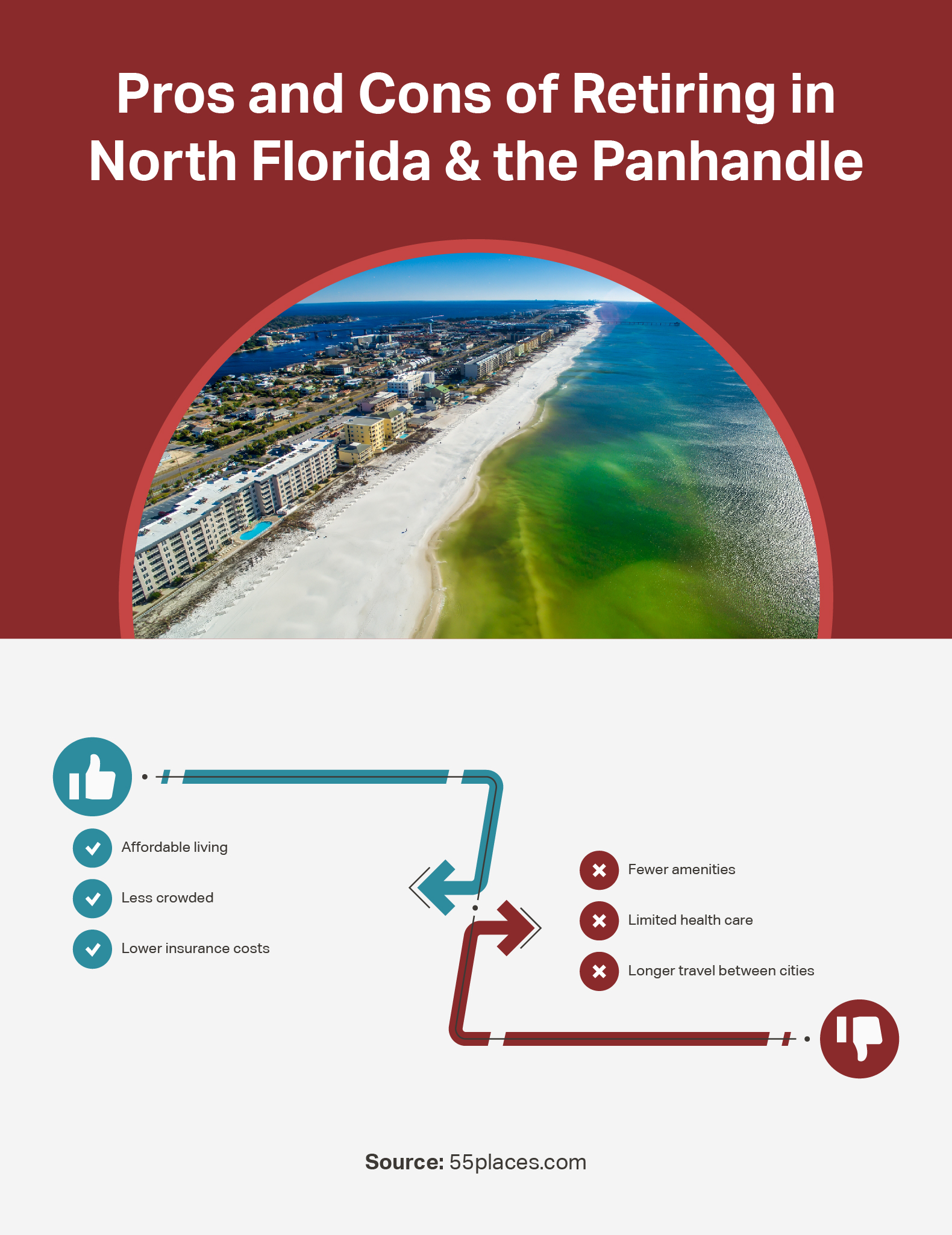
Best Places to Retire in North Florida/Panhandle
Tallahassee
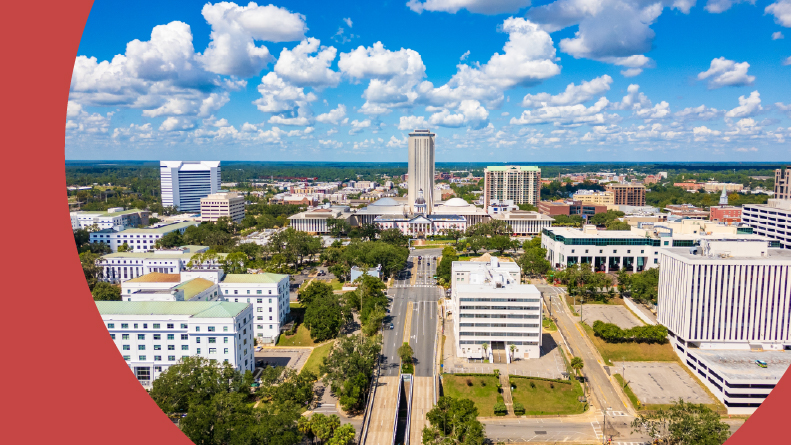
North Florida and the Panhandle are packed with unique places to retire, and one of the most well-known is Tallahassee, the capital of Florida. Locals affectionately refer to it as “Tally,” and the city provides key benefits for retirees.
A University Town
Tallahassee provides an ideal location for an affordable Florida retirement with proximity to top hospitals and medical services, with highly rated health care facilities such as Tallahassee Memorial Healthcare and HCA Florida Capital Hospital. Tallahassee also boasts the most educated population in the state, as nearly half of residents have bachelor’s degrees or higher, according to the city’s Office of Economic Vitality.
Culture and Outdoor Recreation
As a vibrant university town, Tallahassee offers plenty of cultural attractions, museums, concerts, and festivals to explore. Well-known annual events include the Tallahassee Jazz & Blues Festival, Springtime Tallahassee, Shakespeare in the Park, and the North Florida Fair. Also, the Railroad Square Arts District hosts a monthly arts festival with galleries, shops, music, and food.
Residents of Tallahassee benefit from its scenic hilly landscape, providing an abundance of greenspaces, parks, lakes, and trails. The notable Tallahassee-St. Marks Historic Railroad State Trail, ideal for walking, jogging, and biking, runs from the capital city to the coastal community of St. Marks. Retirees can conveniently reach Gulf of Mexico beaches within one hour.
55+ Housing Options
Housing options for Tallahassee retirees include single-family homes in well-established neighborhoods and 55+ communities in surrounding suburban areas. Active adults can find affordable homes with access to amenities and lifestyle activities in Tallahassee.
Gainesville

Gainesville attracts North Florida retirees seeking top-rate health care access, affordable real estate, and an energetic college-town atmosphere. Its location, about one hour from both the Gulf and Atlantic Coasts, allows residents to enjoy a more temperate climate without the risks of extreme coastal weather. Also, active adults in Gainesville enjoy the peace of mind that comes with first-class health care access. UF Health Shands Hospital ranks among the best in the country, with national rankings for the treatment of cancer, neurology, and pulmonology as well as geriatric care.
An Energetic Atmosphere
Gainesville retirees enjoy a laid-back town with a progressive atmosphere and a strong local food scene. With more than 30 miles of biking and hiking trails across seven state parks, retirees can make the most of their time outdoors. Many residents enjoy biking, hiking, fishing, horseback riding, and outdoor recreation surrounded by the scenic landscapes found throughout “Tree City, USA.”
Education and Entertainment
Retirees seeking a North Florida town with scenic natural beauty, vibrant culture, and interesting history can find a lot to love about Gainesville. Popular attractions include the Florida Museum of Natural History, Matheson History Museum, and Harn Museum of Art. The University of Florida, the state’s oldest and largest institution of higher education, also calls Gainesville home. With Disney World, Universal Studios, and Busch Gardens within a two-hour drive, Gainesville residents have access to world-class entertainment.
55+ Housing Options
Gainesville retirees can find a complete range of housing options, including senior apartments, townhomes, and single-family homes. Active adults can find the home type and floor plan that best meets their needs, preferences, and budget, all with a more affordable price tag than coastal Florida.
Pensacola
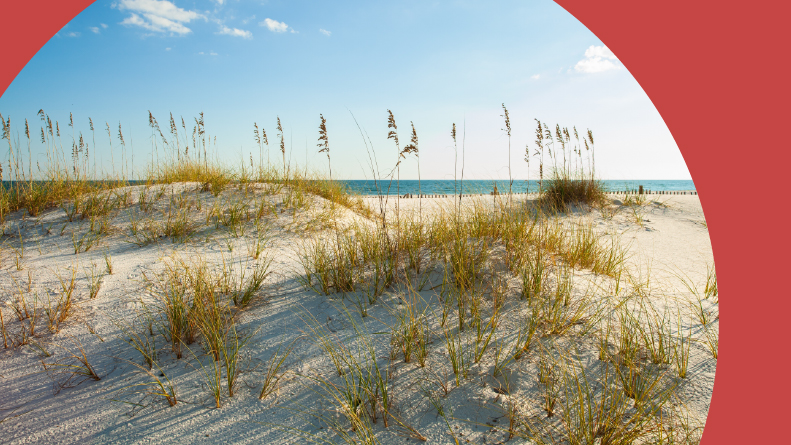
Pensacola ranks among the best places to retire in North Florida for its white sandy beaches, historic downtown with a walkable waterfront, and its strong support for veterans and military families. Residents of this resort community enjoy sunny weather, beachside recreation, and plenty of opportunities for social and physical activities. Also, active adults can find top-quality care at facilities such as Ascension Sacred Heart, Baptist Hospital, and HCA Florida West Hospital.
Southern Hospitality and Coastal Charm
The Pensacola retiree lifestyle blends Southern hospitality with coastal charm, making the city an ideal destination for beach lovers, boaters, and military retirees. The walkable waterfront downtown district—featuring local shops, restaurants, bars, and boutiques—provides an easygoing backdrop with something to do every night of the week. Unique things to do include visits to the National Naval Aviation Museum, Five Flags Speedway, and Pensacola Museum of Art.
Centuries of History
Retirees interested in learning about the past can find centuries of history to uncover in Pensacola. Among the earliest Spanish settlements in Florida, Pensacola has preserved its historic roots and blended them into the uniquely coastal atmosphere of the town. Must-see attractions include Historic Pensacola, Pensacola Lighthouse and Maritime Museum, and Plaza Ferdinand. Fort Pickens, along the Gulf Islands National Seashore, offers scenic tours and activities.
55+ Housing Options
Retirement real estate options in Pensacola primarily include single-family and condominium homes. Retirees can find single-family and condo homes with a downtown or a beachfront lifestyle given that many homes feature scenic water views. A mix of new and resale homes for sale ensures that active adults can find the right home.
Panama City & Panama City Beach
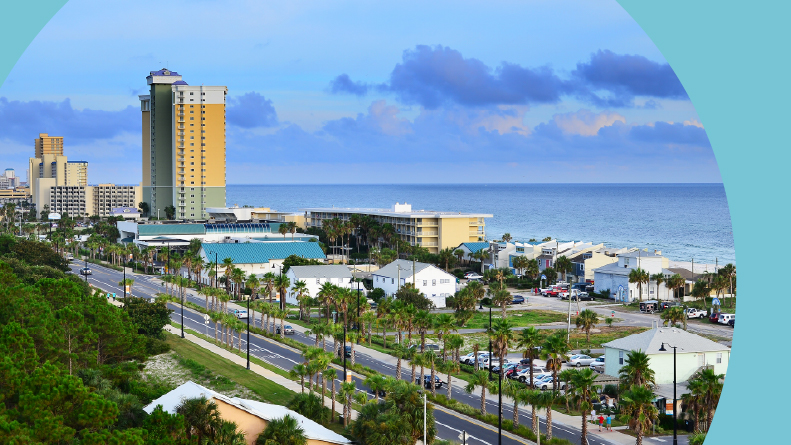
With its relaxed beach-town energy, scenic coastline, and affordable housing prices, Panama City and Panama City Beach attract retirees seeking an oceanside retirement in North Florida. Real estate prices in the area typically trend more than 25% below the national average, meaning that Panhandle retirees can find what they want for less—including homes just steps away or down the street from the beach.
Miles of Shoreline
Seasonal snowbirds have long flocked to Panama City Beach for its temperate climate and pristine beaches, which offer easy access to boating, fishing, snorkeling, birdwatching, and swimming. With 27 miles of shoreline and 320 days of sunshine each year, Panama City is an ideal retirement spot for beach lovers. Nearby hidden gems include Shell Island and St. Andrews State Park, where beachcombers walk at daylight to collect shells and observe marine creatures like sea turtles.
Attractions All Year
However, the area offers numerous attractions to explore during its off-season, including the Man in the Sea Museum, Zoo World, and Signal Hill Golf Course. With seasonal average temperatures that remain in the mid-60s even in the winter months, retirees in Panama City can enjoy outdoor recreation throughout all four seasons, including tennis, pickleball, and hiking.
55+ Housing Options
The housing options for retirees in the Panama City Beach area include affordable beachfront condos and inland subdivisions with single-family homes. Wherever retirees land, they will never be too far from Florida Panhandle beaches, making PCB one of the best places to retire in North Florida.
Fernandina Beach & Amelia Island
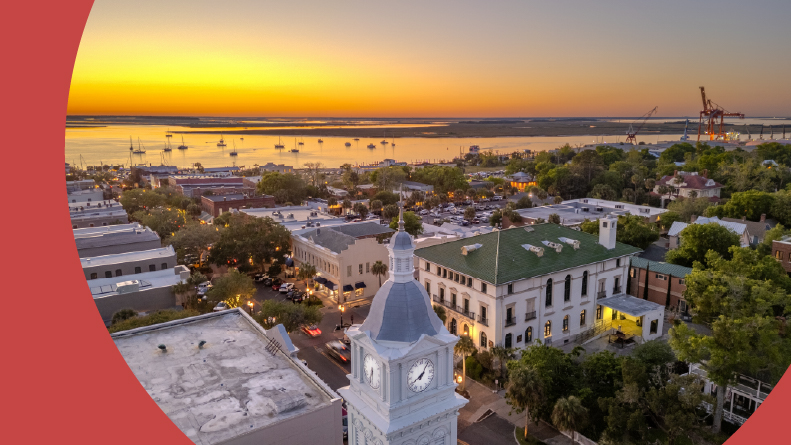
Located in the northeast corner of Florida, Fernandina Beach and nearby Amelia Island capture the feel of historic seaside downtowns with uncrowded beaches. These small twin cities along the Atlantic Coast attract retirees seeking a getaway that feels like a return to a laid-back lifestyle without the crowds often seen at Florida’s most popular destinations.
For History and Nature Lovers
Fernandina Beach and Amelia Island offer coastal wetlands, marshes, and Atlantic Coast beaches, providing retirees with opportunities to fish, boat, swim, and engage in various water sports. Ideal for history and nature lovers, the beachfront Fort Clinch State Park spans 1,400 acres, offering opportunities for hiking, camping, fishing, and shelling. The Amelia Island Trail connects to the East Coast Greenway, joining a 3,000-mile trail system that connects Maine to Florida. Also, the peaceful lifestyle that retirees experience in Fernandina Beach and Amelia Island includes regular beachcombing, waterfront dining, golf, and community events like the Isle of Eight Flags Shrimp Festival.
Prime North Florida Location
Retirees in Fernandina Beach and Amelia Island enjoy convenient access to nearby metropolitan areas, as they can reach Jacksonville and Jacksonville International Airport within 35 minutes. Nearby top-notch health care facilities include the Mayo Clinic in Jacksonville, Ascension St. Vincent’s Riverside, and Baptist Medical Center. The North Florida location makes the area a great home base for retirees who want to venture to vacation destinations or travel to visit family and friends.
55+ Housing Options
Snowbirds and permanent residents alike should consider the diverse real estate options that the area has to offer. Housing options include high-end oceanview condominiums, townhomes in gated communities, and low-maintenance single-family homes.
Additional North Florida and the Panhandle Resources
- The Best Retirement Communities in the Florida Panhandle
- South Carolina vs Florida: Which Is Better for Retirement?
- Georgia vs Florida: Which Is Better for Retirement?
- Is It Better to Retire to Florida or North Carolina?
- Best Beach Retirement Towns in Florida: Find Your Ideal Spot
- Is It Better to Retire on the East or West Coast of Florida?
- Arizona vs. Florida: Which Retirement Destination Is Right for You?
Housing in North Florida/Panhandle – Options, Costs & Communities

55+ and Active Adult Communities
Retirees looking to move to North Florida can find the right home in a 55+ or active adult community. The south end of the state is more well-known for being packed with age-restricted communities, including some of the most popular in the world like The Villages, Latitude Margaritaville, and On Top of the World. However, the number of 55+ communities is growing in North Florida.
Living in a 55+ community often encourages a healthy and social lifestyle. Age restrictions (most often 55+) ensure that homeowners are surrounded by like-minded individuals seeking a similar pace of life. Most 55+ communities come with a range of amenities like clubhouses, athletic facilities, and pools. Many of these communities also include homeowners’ associations (HOAs) that take care of headaches like lawn care, exterior home maintenance, and landscaping so residents have more time to enjoy their retirement in peace.
In the Panhandle, 55+ communities can be found in higher densities around the major cities of Pensacola, Panama City Beach, and Tallahassee. Active adults seeking to retire in North Florida often gravitate to these cities for the conveniences and entertainment they provide. Many 55+ communities can also be found on the Panhandle’s Gulf Coast, which provides active adults with quaint coastal towns and easy beach access.
“We’ve seen a rise in thoughtfully planned 55+ communities across North Florida and the Panhandle. These neighborhoods often offer golf courses, clubhouses, or wellness amenities so retirees can enjoy both comfort and community.”
-Bill Ness, Chief Executive Officer, Founder, & Illinois Managing Broker at 55places.com
55+ Communities in the Florida Panhandle
- Latitude Margaritaville Watersound
- Watersound Origins
- LiveOak Village
- Leisure Lake
- Firefly at Hammock Bay
- Ethos
- Oyster Bay Village
- Windsor Villas
- Sea Pines at Bon Secour
- The Village at Craft Farms
55+ Communities in North Florida
- Del Webb Ponte Vedra
- Sweetwater
- Del Webb Nocatee
- WaterSong at RiverTown
- Del Webb Wildlight
- Stillwater
- Del Webb eTown
- Cascades at World Golf Village
- Parkland Preserve
- Reverie at Silverleaf
- Summer Bay at Grand Oaks
- Reverie at TrailMark
- Villages of Seloy
- Freedom at Sawmill Branch
- Artisan Lakes
- Everlake at Mandarin
- Lakeview at Tributary
- Bridge Bay at Bannon Lakes
- Freedom at Arbor Mill
- Matanzas Lakes
- Freedom at San Salito
- The Residences at World Golf Village
- Edenbrooke at Hyland Trails
- Freedom at Azalea Ridge
Additional Resources:
New Construction vs. Resale
When it comes to buying a home, retirees may have the opportunity to build a home in a 55+ community rather than move into a resale property. Though North Florida has a more limited supply of homes on the market than the rest of the state, new construction and resale homes still remain as options. Pros and cons exist for both home types, and in the end, it comes down to individual preference, home availability, and personal budgets.
Additional Resources
New Construction Homes
Building a home in a 55+ community can be a rewarding experience that leaves homeowners with a customized abode. Building a home from the ground up comes with advantages, like being able to choose the plot of land upon which their dream home will be built. Also, owners of new homes may not need to worry about maintenance issues like appliances breaking down or roofs needing to be replaced for a considerable amount of time, but that’s not to say there aren’t some downsides to consider.
Pros of New Construction Housing in North Florida
- Modern Layouts: New construction homes in 55+ communities often feature modern amenities, including open-concept floor plans, smart home technology, first-floor primary suites, accessible storage, and ample indoor and outdoor space for entertaining family and friends.
- Customization Options: When a buyer chooses a pre-designed floor plan from a 55+ community builder, it often comes with a wide range of customizable options that include both structural and aesthetic design choices for the inside and outside of the home. Add-ons like covered porches, finished basements, second-story lofts with additional suites, three-car garages, vaulted ceilings, electric fireplaces, and expanded closet space are just some of the options that may be offered.
- Energy Efficiency: Modern windows, roofs, and building materials reduce energy consumption by better insulating a home, and energy-efficient appliances reduce the use of excess water and electricity. While it’s possible to install these features in a resale home, it can be an expensive venture that comes with ongoing construction within your home for extended periods of time.
- Builder Incentives: Builders want people to choose them to build their new homes—obviously—so they will often offer incentives to buy from them. Incentives can include anything from free home upgrades to credit towards closing costs or lower interest rates.
Cons of New Construction Housing in North Florida
- More Expensive: Building a home will likely cost the buyer more per square foot than purchasing a resale home. Buying a home comes with a long list of expenses, including labor, materials, inspections, and anything that might go awry during construction. It’s a rewarding experience, but often an expensive one as well.
- Longer Timelines: It takes time to build a home from the ground up when compared to simply buying a resale home and moving in. Everything, from the foundation to the walls, electrical components, plumbing, and roof, must be installed, often leading to months or even years of waiting for completion.
- Less-developed Locations: Plots to build new construction homes are often located in less-developed areas since most cities and towns are already full of existing homes. It’s not impossible that there’s room for new homes in desirable areas, but owners of new construction homes will likely need to drive a little farther than others to reach some conveniences.
Resale Homes
Buying a resale home is far more common than building one and comes with its own list of pros and cons. The process of buying a resale home is often more streamlined than buying a new construction property and comes without the long wait for a home to be finished before moving in.
Pros of Resale Homes in North Florida
- Lower Prices: Buying a resale home is almost always more budget-friendly than building a similar new construction home. Buyers can also negotiate with the current homeowner with a resale home, which can further drop the price tag down.
- Established Neighborhoods: Resale homes are often located in well-established neighborhoods, especially those in 55+ communities. Unlike new construction homes within neighborhoods that are still undergoing construction, resale homeowners can begin utilizing their community’s amenities upon moving in. Buyers can also choose a home in the midst of a popular area without needing to travel far for dining, conveniences, and entertainment.
- Lots of Landscaping: The plot of land a home sits on is also important, especially when it comes to the landscaping. The property surrounding resale homes can often include mature trees, a well-developed lawn, and established gardens. The plots of new construction homes, conversely, often need to be completely cleared before anything new can be planted.
Cons of Resale Homes in North Florida
- Maintenance and Updates: Older homes come with a higher likelihood that something might break. Character comes with issues like structural damage, damp crawl spaces, leaky roofs, and appliances on their last leg. The aesthetic of a home can also feel outdated, with many modern homeowners choosing to do away with things like old wallpaper, shag carpet, and popcorn ceilings. Sometimes these issues can be used to negotiate when buying a resale home, but keep in mind not every inevitable problem will be present at the time of the sale.
- Competitive Market: Buying both new construction and resale homes can be a headache, but the resale market can be especially competitive and even lead to bidding wars between buyers, depending on market trends. Luckily, with the help of 55+ real estate experts like the ones at 55places, navigating the process of buying a home can be simplified and productive.
Home Prices in North Florida & the Panhandle
For retirees on a fixed income, housing costs can be an important deciding factor when choosing where to live. Active adults might wonder, “is the Florida Panhandle a good place to live to save money?” Fortunately, home prices in North Florida trend below real estate costs in other parts of the state. Home prices in the Panhandle tend to be more affordable than those in the Gulf Coast and Atlantic Coast regions due to their competitive markets and higher population density.
“Compared to many other retirement destinations, the Panhandle offers retirees an exceptional value. Homebuyers are often pleasantly surprised to find that they can enjoy modern homes, resort-style amenities, and proximity to the beach at price points that stretch their retirement dollars further.”
Some of the most affordable housing in Florida can be found in North Florida—even in the larger regional cities. Pensacola, for example, typically sees housing costs 9% lower than the national average with a median home price around $470,000 and a median monthly rent around $1,400. Even Tallahassee, the largest city in the Panhandle, boasts housing costs 15% lower than the national average with a median home price around $440,000 and a median monthly rent of $1,300.
Retirees might have their eye on the Panhandle as a possible location to snowbird for the winter. Snowbirding refers to moving south for the winter as active adults decide they would rather spend the colder months, typically October through April, somewhere warm. Florida remains as the top snowbird destination in the U.S., prompting many to consider the Panhandle for its affordability.
Snowbirds can find a variety of home types to rent seasonally. Condominium homes and apartments are both popular choices due to their maintenance-free lock-and-leave lifestyle. Retirees should also consider leased single-family and attached homes within 55+ communities that provide more space and come with amenities.
Additional Resources
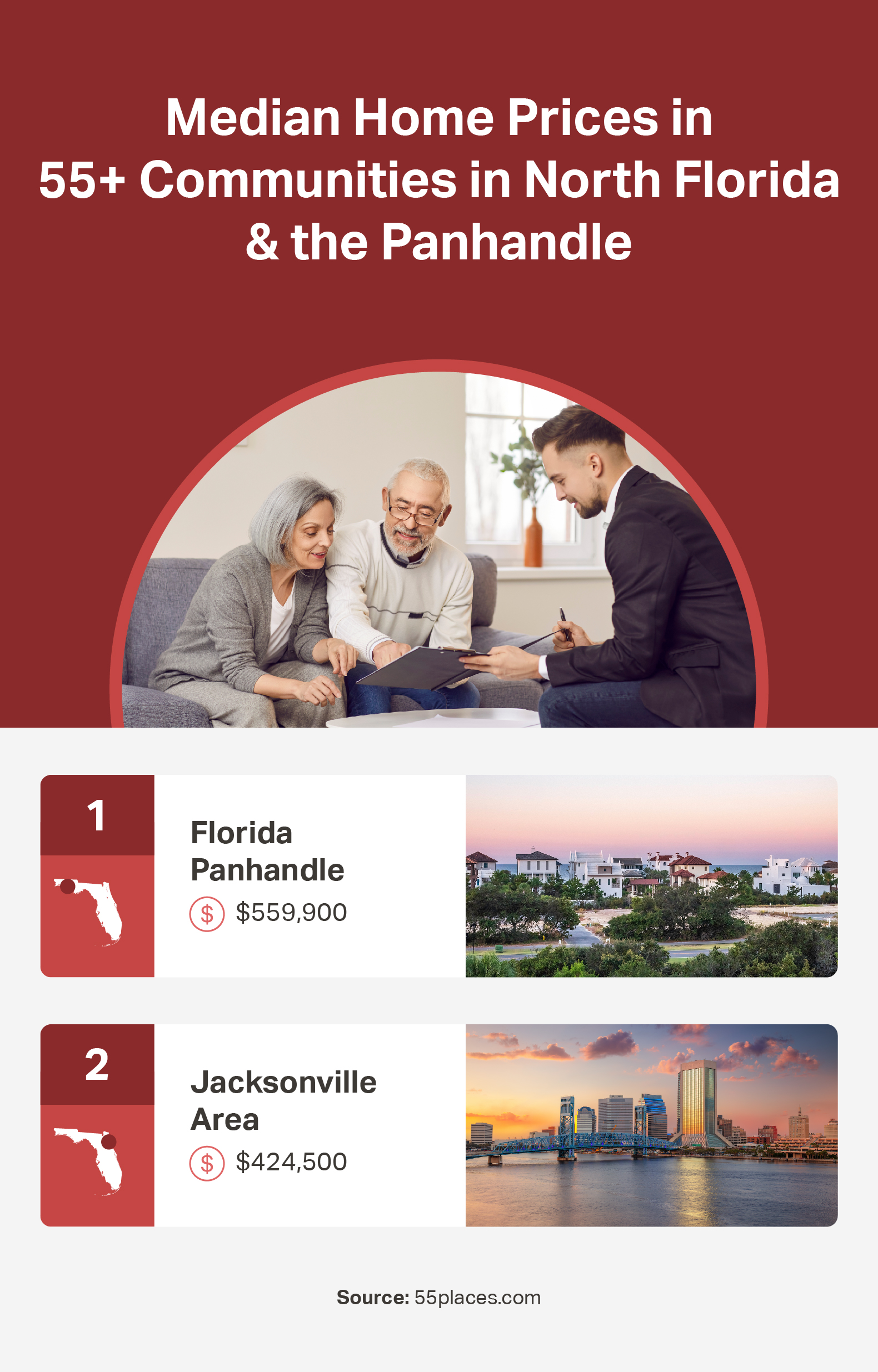
HOAs, Flood Zones, and Insurance Considerations
Retirees looking to buy a home in North Florida should be aware of additional fees and insurance costs that may be unexpected for out-of-state buyers. For example, homeowners in the Panhandle need to prepare for hurricanes and tropical storms. There are several tasks to be done to minimize damage, such as installing impact-resistant windows, trimming nearby trees, moving outdoor furniture inside, and coming up with a plan in case of an emergency.
Those from other states may think they need hurricane insurance, but that doesn’t explicitly exist. Hurricane insurance is actually just a combination of homeowner’s insurance for wind and flood damage. Luckily, active adults can often find better insurance rates in North Florida compared to the rest of the state.
For those planning to build a new construction home on or near a coast, be aware of elevation requirements. Based on a home’s floodplain, it needs to be elevated a specific distance off the ground to avoid damage from flooding. Homebuyers should visit Floodsmart.gov to learn more.
Retirees moving to a 55+ community for the first time should also research HOA fees in their respective community. HOA fees are primarily used for community maintenance, amenity and facility upkeep, security, and improvements. HOA fees vary greatly from community to community, so homebuyers should take a close look at what they entail before buying a home.
Additional Resources
- Benefits of an HOA: Why 55+ Homebuyers Want a Homeowners’ Association
- Buying a Home With or Without an HOA
- Everything You Need to Know About a 55+ Community HOA
- Homeowners Insurance for Seniors: A Comprehensive Guide
- Understanding Florida Homeowners Insurance: What to Expect and How to Prepare
Cost of Living, Health Care & Local Services
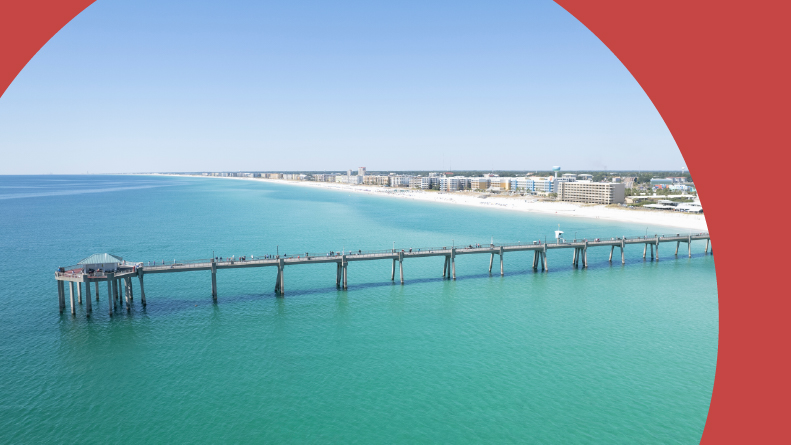
Cost of Living Comparison
An area’s cost of living is an overall estimate of how much everyday expenses will cost a resident. It takes into account expenses like groceries, utilities, housing, transportation, and entertainment. While cost of living data is helpful for comparing cities and states, individuals may pay more or less than average due to lifestyle choices and personal budgets.
According to Payscale, Tallahassee is the most affordable place to live in the Panhandle, with an average cost of living 7% lower than the national average. Residents of Tallahassee save about 15% on housing and groceries. Pensacola is budget-friendly with an overall cost of living 4% lower than the national average. Residents tend to save on housing, groceries, and transportation expenses.
Other North Florida cities like Gainesville, Fernandina Beach, and Panama City Beach are all slightly above the national average cost of living, but not by much. Despite this, Gainesville residents save on utilities and groceries, Fernandina Beach residents save on utilities and transportation, and Panama City Beach residents save on groceries and housing when compared to national averages.
Smaller coastal towns like Niceville, Navarre, and Apalachicola all rank around 4% below the national average cost of living, providing more affordable options to retire seaside than in the larger cities.
Compared to South Florida
When compared to South Florida, the cost of living in Panhandle cities is more affordable than in cities located on the South Atlantic Coast. For example, the overall cost of living in Miami is 21% more expensive than the national average, Fort Lauderdale is 23% more, and Pompano Beach is 11% more. Florida retirees can actually save money by finding a home in the Panhandle.
The cost of living in Panhandle cities is surprisingly comparable to South Gulf Coast Cities like Tampa and Fort Myers as well as Central Florida cities like Orlando, which are all within 4% of the national average. Despite this, the Panhandle remains more affordable than the southern part of the state due to factors not taken into account by cost-of-living calculations, like property taxes.
Additional Resources
- How Much Does It Cost to Retire in Florida?
- Understanding Florida Homeowners Insurance: Where to Expect and How to Prepare
- Can I Retire in Florida on $3,000 a Month?
- How Long Will $1 million Last in Retirement in Florida?
- Social Security Changes for Florida Retirees in 2025
- Best Places to Retire in Florida on a Budget
- Luxury Retirement Communities Florida
- 55+ Communities in Florida Under $100,000 With Homes for Sale
- Best Lowest-Priced Communities in Florida (With Low HOA Fees)
Health Care Access
Due to Florida’s large population of active adults, most of the Sunshine State’s major hospitals are well-equipped to address the unique needs of retirees and residents aged 55 and above. The Panhandle and North Florida is no exception, making it one of the best places to retire for health care. Residents in the region have access to many quality medical centers for both routine and specialized care.
Top Hospitals
In Gainesville, the University of Florida Health network provides patients with first-class care. The institution boasts award-winning centers in oncology, heart care, and neurology. Additionally, UF Health Shands Hospital is nationally ranked in seven adult medical specialties.
Tallahassee Memorial Health ranks nationally in oncology, bariatric, vascular, and neurology care, with U.S. News ranking it as one of the top hospitals in Florida. Some of the hospital’s most well known and practiced treatments include heart attacks, knee and hip replacements, and kidney failures.
Over in Pensacola, retirees can get treated by trusted medical professionals at a Baptist Health medical center. Baptist Hospital in Downtown Pensacola has been recognized as a Primary Resuscitation Center of Excellence, one of many awards and accolades accumulated by the institution. Also, U.S News ranks Baptist Health high in its patient experience rankings and considers 10 of its adult specialties as high performing, including geriatrics, orthopedics, and cardiology.
VA Hospitals
For retirees who are also veterans, they can seek care at one of several VA hospitals in the Panhandle region. VA hospitals provide specialized treatments that cater to the unique needs of veterans. VA hospitals can be found in all the major North Florida cities, including Pensacola, Panama City, Tallahassee, and Gainesville, as well as several more in smaller cities and towns.
Additional Resources
- 55+ Communities Near the Best Hospitals in Florida for Seniors
- The Best Places to Retire for Health Care
- How Do 55+ Communities Handle Health Care and Emergency Services?
Taxes
Florida taxes help retirees save money in several ways when compared to the taxes in other states, making it an appealing state for retirement. A primary benefit of retiring in Florida is the complete lack of a state income tax, including taxes on Social Security benefits, 401(k)s, pensions, and other forms of retirement income. Due to this policy, retirees can maximize their monthly income.
Florida enforces no estate or inheritance taxes, making it an ideal state for those looking to promote generational wealth. Also, the statewide sales tax rate comes out to 6%, with local sales tax rates usually making the total around 7%.
Panhandle Property Taxes
In terms of property taxes, the Panhandle has nine out of ten of the cheapest counties for property taxes in the state, according to SmartAsset. Walton County, located between Panama City and Destin, is the most affordable, with a tax rate of only 0.45%. Escambia County and Bay County, which hold Pensacola and Panama City, respectively, each have a reasonable tax rate of 0.60%.
Florida Tax Exemptions
Florida provides some exemptions that retirees can use to save money on annual taxes. The Homestead Exemption is a significant one, allowing homeowners to exempt up to $25,000 from the first $50,000 of the home’s assessed taxable value, and then exempt another $25,000 for assessed values between $50,000 and $75,000. For example, if a home is assessed to be worth $80,000, homeowners can exempt up to $50,000 of the assessed value and only pay taxes on the remaining $30,000.
Another helpful policy is the Save Our Homes benefit. This Florida Constitutional Amendment caps the increase in a home’s assessed value at 3%, even if the actual assessed value has risen far greater than that. The Save Our Homes benefit keeps property taxes from skyrocketing regardless of changing market conditions.
Additional Resources
Is North Florida/Panhandle Retirement Right for You?

Though the southern part of the state remains one of the most popular 55+ hotspots in the country, North Florida shares many of the attractive attributes that active adults seek in a retirement destination. In fact, the Panhandle offers some benefits not found elsewhere in the state. Southern Florida may hold more developed beach towns and big cities with high-end destinations, but North Florida boasts its own inimitable charm.
The larger cities like Pensacola and Tallahassee offer the attractions, dining, shopping, and conveniences, but the smaller towns in between offer a quiet, secluded lifestyle that some retirees may seek. Southern Florida tends to be more densely populated than the Panhandle in popular areas, a fact that may be important to retirees looking for some breathing room.
Do You Enjoy Hilly Terrain and Cooler Temperatures?
North Florida showcases a different environment than the southern part of the state, with more deciduous forest and hilly terrain. The temYerature can drop relatively low in the winters, causing the Gulf waters to cool more than they do in places like Miami. Interested homebuyers should consider visiting the Panhandle during different seasons to ensure they enjoy the weather and seasonal changes.
The environment in the Panhandle noticeably varies from the southern extremes of Florida. Retirees imagining the Caribbean waters of Key West or the tropical flora of Orlando may be surprised to find North Florida full of deciduous forests and rolling hills. Retirees who enjoy hiking will find many opportunities to explore expansive state forests and natural areas.
Are You Seeking Affordability?
North Florida is a relatively affordable place to retire when compared to other states and even the rest of Florida. Even in some of the cities like Tallahassee and Pensacola, the average cost of living is less than the national average. Florida’s tax policies continue to be friendly towards 55+ adults, and most of the counties in the Panhandle offer the lowest property tax rates in the state.
How to Determine if the Panhandle Is Right for You
Whether the Panhandle is right for retirement comes down to the individual retiree and their unique preferences. Research is key when deciding where to retire. Retirees interested in North Florida should first decide whether they want to live near the coast or more inland, then determine if they want to live in a bigger city like Pensacola or a smaller town like Destin.
Proximity to everyday locations like grocery stores, restaurants, and entertainment is an important factor of deciding where to retire. Different people want to be close to different conveniences, so active adults should prioritize where they see themselves visiting the most. Areas around major cities like Tallahassee and Gainesville hold most of the destinations retirees need, but homeowners in more rural locales may need to drive a bit farther.
Access to appropriate health care facilities should be a priority to retirees who need specialized care after moving to the Panhandle. Luckily, North Florida is home to a number of nationally recognized medical centers, as well as a number of VA hospitals spread evenly through the region.
Explore Local Active Adult Communities
Retirees should consider moving to a 55+ community in the Panhandle to maximize their dollar when buying a home. Age-restricted communities often come with benefits like amenities, low-maintenance lifestyles, and like-minded neighbors. To decide if a community is a good fit, prospective homeowners can talk to current residents and community representatives to see if what they have to say aligns with the lifestyle they envision for retirement.
Some 55+ communities allow potential homeowners to spend the night within the community to fully immerse themselves in the lifestyle. For example, Del Webb’s Overnight Pass provides residents with a fully furnished home, a golf cart, and access to all amenities within the community.
FAQs About Retiring in North Florida/Panhandle
1. Is North Florida more affordable than South Florida?
North Florida is more affordable than South Florida in many ways. The western half of the Panhandle holds counties with the most affordable property taxes in the state, and cities like Pensacola and Tallahassee boast housing costs far below state and national averages.
The overall cost of living in North Florida, which includes expenses like groceries, transportation, and utilities, averages below Florida’s East Coast. North Florida’s cost of living is more comparable to that of regions like the Gulf Coast and Central Florida.
2. What’s the weather like in the Panhandle?
The Panhandle experiences more seasonal variety than South Florida, but residents of the region can still expect year-round warm weather. Summers are hot and muggy, and temperatures in the winter usually maintain highs in the mid-60s. Residents can expect consistent rainfall throughout the year, but most days are sunny and warm.
3. Are there many 55+ communities in North Florida?
Yes, an abundance of 55+ communities can be found in North Florida and the Panhandle. The region holds desirable elements sought after by many retirees, including vibrant cities, pristine beaches, and shady forests for outdoor recreation. Interested homebuyers can investigate 55+ communities like Latitude Margaritaville Watersound and Windsor Villas to begin their search.
4. What are the safest towns in North Florida to retire?
North Florida and the Panhandle is are safe places to retire. Pensacola consistently ranks among the safest cities in both the Panhandle and the entire state. Additional towns known for a safe and secure lifestyle include Niceville, Destin, and Milton.
5. Is health care easily accessible in the Panhandle?
Yes, health care is easily accessible in the Panhandle. Major North Florida cities like Tallahassee, Panama City Beach, and Gainesville all boast award-winning medical institutions. Due to the high population of 55+ inhabitants in Florida, most hospitals and medical centers are equipped to handle conditions afflicting active adults. Institutions like the University of Florida Health network in Gainesville and Tallahassee Memorial Health rank high in fields like cardiology, neurology, and oncology.
6. How does the Panhandle compare to the Gulf Coast for retirement?
While both the Panhandle and Gulf Coast have their benefits as retirement destinations, the Panhandle may be better suited for retirees looking to live a quieter, laid-back lifestyle. North Florida is far less crowded than the rest of the state, especially the inland region. The coasts of Florida’s peninsula are densely populated with sprawling cities and grid communities. In contrast, the coast of the Panhandle includes many beach towns that lack crowds even in the most touristy months of the year.
7. What are the best Panhandle beach towns for retirees?
Many quaint beach towns call the Panhandle home. Seaside destinations like Destin, Miramar Beach, Mexico Beach, and Port St. Joe offer retirees affordable housing, local attractions, white-sand beaches, easy access to conveniences, and the highly sought-after beach town vibe.
8. Can veterans find good services in the Panhandle?
Yes, various organizations and institutions serve and support veterans in the Florida Panhandle. One organization, the Panhandle Warrior Partnership, coordinates support for North Florida veterans in various ways, including helping them enroll in benefits, find employment, and connect through recreational activities. Veterans in the Panhandle can also receive care at VA hospitals found in major cities like Pensacola, Tallahassee, and Gainesville.
9. Is North Florida a good fit for retirees?
North Florida is an ideal fit for retirees seeking a destination with white sand beaches, accessible cities, seasonal weather variety, sprawling state and national parks, and an affordable cost of living. The region is known for blending the southern charm of states like Alabama and Georgia with tax benefits and scenic coasts of Florida. The inland portion of the Panhandle offers residents a quiet, rural atmosphere that provides easy access to the Gulf Coast and lively cities.
10. What are housing prices like in North Florida?
The cost of housing in cities like Pensacola and Tallahassee has dropped in recent years, according to Newsweek, with the median home price and monthly rent averages falling below state and national levels. In smaller Panhandle towns and communities, especially those in the inland region, retirees can find low home prices in areas full of conveniences, entertainment, and health care access.
Recap of North Florida and the Panhandle
Active adults trying to decide if they should retire to North Florida and the Panhandle should consider the facts to help with their decision.
- North Florida is overall more affordable than the rest of the state, with affordable property taxes, housing costs, and insurance rates.
- The Panhandle is less crowded, only containing around six percent of Florida’s population across one-fourth of the state’s geographical area.
- North Florida features a variety of cities, including Tallahassee, Gainesville, Pensacola, Panama City, and Fernandina Beach.
- The region experiences more seasonal variety than South Florida and gets slightly cooler in the winter in its northern reaches.
- Residents of North Florida can find easy access to accredited health care systems and VA hospitals when they need medical care.
- Opposed to South Florida’s tropical vibes, North Florida features deciduous forests and hills more akin to other southeastern states like Georgia.
Discover Your Perfect Florida Retirement Destination
Whether you’ve just started thinking about where you want to retire or you’re ready to buy a home, our experts at 55places can help you navigate your retirement journey. We provide in-depth insights on regional real estate and 55+ communities to help active adults find their dream homes.
Sign up for our newsletter to stay up to date on 55+ housing market trends in North Florida and the Panhandle. Explore 55+ communities in North Florida and the Panhandle today!

